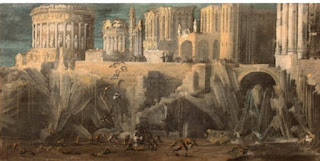What is Surrealism in art? Surrealism is an art style that developed in the 1920s, largely as a response to the horrors of the First World War. It is challenging to pin down a coherent Surrealism art definition because the movement itself resists categorization. However, at its core, Surrealism aimed to access and celebrate the unconscious mind, free of the constraints of formal Enlightenment thinking. While Surrealism is today most closely associated with visual art, it was also a movement that encompassed literary works, poetry, cinema, music, and even politics. Surrealism as a movement tapered off in the 1960s, but its influence is still felt in the art and literature of the present day.
While Surrealism got its start in the 1920s, there were many art movements and individual works of art that provided important inspiration for Surrealism. Some early artists combined elements in strange ways much like the Surrealists did. For example, French painter François de Nomé was born in 1593 (date of death unknown) and produced artwork that could be considered proto-Surrealist.
Surrealism Art Characteristics
- Expressions of the subconscious mind
- Art designed to unsettle and transgress boundaries
- The liberation of thought and language
- Chance, randomness, and
- unpredictability
The characteristics of surrealism are evident in the work of many artists, some of whom developed their own new artistic mediums. Max Ernst, for example, developed the styles of frottage and grattage, which were methods where Ernst would scrape away parts of an image to create a textured effect. Many other Surrealists used existing painting styles, although some ventured into the realm of sculpture. Surrealism also began to filter into the poetry of the age, as with the poem Pyjama-Speed by Simone Yoyotte.
While Surrealism declined in the 1960s and is no longer an active art movement, its principles and iconic images have remained a part of the popular imagination for decades. Styles like postmodernism and absurdism, as well as many forms of abstract art, owe their origins to Surrealism. A notable contemporary homage to Surrealism as a movement can be found in The Last Days of New Paris, a novella by English author China Miéville. This book features dozens of examples of Surrealist art that have come to life in an alternate history of Paris in 1950.
An artistic and literary movement that emerged in the 1920s, inspired by Freudian psychology and the exploration of the subconscious mind. Surrealists sought to unlock the power of the imagination by tapping into dreams, fantasies, and irrational thoughts.
3) Dada movement:
What is Dada movement ?
The Dada movement in literature emerged in the early 20th century as a response to the chaos and disillusionment brought about by World War I. It rejected traditional forms of artistic expression, aiming to shock and provoke audiences. Dadaists often used nonsensical language, fragmented narratives, and absurd imagery to challenge societal norms and conventions. Prominent figures in Dada literature include Tristan Tzara, Hugo Ball, and Marcel Duchamp. The movement had a significant influence on surrealism and other avant-garde movements that followed.
History and origin of Movement:
The Dada movement was a cultural and artistic phenomenon that emerged in response to the disillusionment and absurdity of World War I. It originated in Zurich, Switzerland, around 1916, but quickly spread to other European cities such as Berlin, Paris, and New York City. The movement encompassed various forms of artistic expression, including literature, visual arts, performance, and sound.
Characteristics of the Dada movement in literature include:
1. Anti-Art:
Dadaists rejected traditional artistic conventions and sought to undermine the notion of art itself. They often created works that were deliberately nonsensical, provocative, or absurd.
2. Nonsensical Language:
Dada literature frequently employed fragmented narratives, random wordplay, and nonsensical language to disrupt conventional communication and challenge the rationality of society.
3. Collage and Montage:
Dadaists used techniques such as collage and montage to create new meanings by juxtaposing disparate elements from everyday life, often resulting in unexpected and surreal combinations.
4. Subversion of Authority:
Dadaists aimed to subvert authority and challenge established power structures, including political, cultural, and artistic institutions. They sought to disrupt the status quo and provoke social change through their unconventional methods.
5. Manifestos and Performances:
Dadaists often wrote manifestos to articulate their beliefs and intentions, while also staging provocative performances and events to shock and confront audiences.
Example:
Tristan Tzara, a key figure in the Dada movement, wrote the "Dada Manifesto" in 1918, which encapsulated many of the movement's principles.
One of Tzara's most famous Dadaist poems is "To Make a Dadaist Poem," which instructs the reader to cut out words from a newspaper, place them in a bag, and then randomly draw them out to create a poem. This method exemplifies the Dadaist rejection of traditional poetic forms and embrace of chance and randomness.
A radical artistic and literary movement that originated during World War I, characterized by its rejection of traditional aesthetic values and embrace of chaos, absurdity, and anti-establishment attitudes. Dadaists sought to dismantle societal norms and challenge the very concept of art through nonsensical language, collage, performance, and provocative manifestos.
Thank you
Be Lerner....








